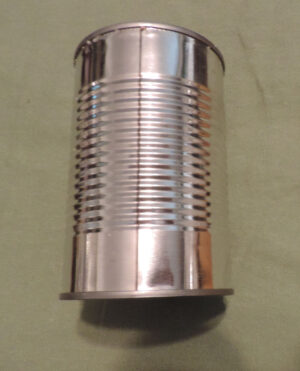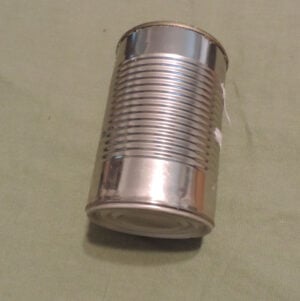With time, everything changes even the tin can. The tin can used to be made of three pieces. A top and bottom and a plate formed into a cylinder and soldered with lead solder. Today the cans are two piece a top and the rest is one piece made by feeding metal into a large press that forms the body.
In the traditional three piece can they currently use welds on the side seam, except in some that come from overseas. The majority of cans that still use the lead solder are used for dry food. You can recognize the ones with lead seams quite easily. First, peel back the label to expose the seam. The edges along the joint of a lead-soldered seam will be folded over. Silver-gray metal will be smeared on the outside of the seam. I would avoid any cans that are soldered with lead. A welded seam is flat, with a thin, dark, sharply defined line along the joint.

Today it seems like tin cans are thinner and many of the ones packed in other countries seem to fail sooner. It has been my experience that off brand and some store brand cans fail sooner than the top name brands. Cans containing high acid foods such as tomatoes, pineapple, citrus juice and other fruits seem to fail the quickest.
I see changes in other types of packaging, such as more use of plastic that does not store long term
How to recognize tin can and packaging problems
“Never eat food from a tin can with bulging ends” was a maxim we have all heard. But there are other things you should watch for including.

Tin Cans
- an obvious opening underneath the double seam on the top or bottom of the can
- a can with bulging ends
- a fracture in the double seam
- a pinhole or puncture in the body of the can
- an unwelded portion of the side seam
- a leak from anywhere in the can
- dents that damage any of the seals
Plastic Cans
- any opening or non-bonding in the seal
- a break in the plastic
- a fractured lid
- a swollen package
- shorter shelf life
Paperboard Cans
- a patch in the seal where bonding or adhesive is missing
- a slash or slice in the package
- a leak in a corner of the package
- a swollen package
Glass Jars
- a pop-top that does not pop when opened (indicating loss of the vacuum)
- a damaged seal
- a crack in the glass of the jar
Flexible Pouches
- a break in the adhesive across the width of the seal
- a slash or break in the package
- a leak at a manufactured notch used for easy opening
- a swollen package
- If you intend to store the food long term be sure the pouches are Mylar.
Today I see many of the food suppliers attempting to cut cost by using cheaper packaging, this can affect us as preppers. Learn how your food should be correctly packaged and pay attention to the packaging when you purchase foods, particularly if you intent to store them for long periods of time.
Howard


Thanks for sharing these packaging problems to watch out for! Great post.